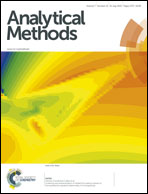A novel strategy for the classification of naturally colored cotton fibers based on digital imaging and pattern recognition techniques
Abstract
This study proposes the use of digital images and multivariate analysis as an alternative methodology for the classification of naturally colored cotton fiber, according to cultivar type. For this purpose, two groups were evaluated: the first comprised of BRS 200 Marrom and BRS Topázio cultivars, while the second contained BRS Rubi and BRS Safira cultivars. Cotton fiber sample images were obtained using a webcam and the frequency distribution of color indexes on the grayscale, red–green–blue (RGB), hue (H), saturation (S), value (V), and grayscale channels was obtained. Classification models based on linear discriminant analysis (LDA) with prior variable selection by successive projection algorithm (SPA) and stepwise (SW) were used. For the purpose of comparison, partial least squares discriminant analysis (PLS-DA) applied to the full-histogram was also used. For both groups, the best results were achieved using the LDA/SW model, with a correct classification rate (CCR) of 96% for the prediction set using the HSV combination. The proposed method is simple, low cost, does not use a reagent, does not destroy the sample and provides results in a short period of time.


 Please wait while we load your content...
Please wait while we load your content...